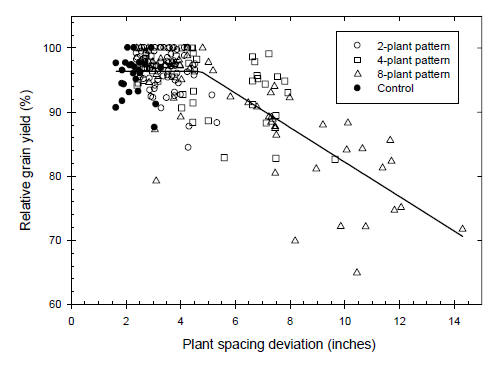August 2008
Field Crops 28.42-61
Trouble with Doubles, Gaps and Peepers
Joe Lauer, Corn Agronomist
Growing Season Update
The 2008 production year has been one of the coolest on record. Growing degree unit
accumulation is tracking about 300 GDUs behind schedule. Temperature drives the
vegetative (V) developmental stages of the corn life cycle, but has less influence
during the reproductive (R) developmental stages (Table 1). The number of days from
silking (R1) to maturity (R6) ranges from 55 to 60 days. A farmer benchmark to gauge
the season is "To be dented by Labor Day." About 26-28 days remain for the crop
to mature.
|
Table 1. Relationship between corn kernel growth stage and development.
|
|
|
|
Growing Degree Units
(GDUs) to Maturity
|
Percent of
Maximum Yield
|
Moisture
Content (%)
|
|
Stage
|
Calendar Days
to Maturity
|
Southern
Wisconsin
|
Northern
Wisconsin
|
Grain
|
Whole
Plant
|
Grain
|
Whole
Plant
|
|
R1- Silk
|
55-60
|
1100-1200
|
950-1050
|
0
|
50-55
|
---
|
80-85
|
|
R2 - Blister
|
45-50
|
875-975
|
800-900
|
0-10
|
55-60
|
85-95
|
80-85
|
|
R3 - Milk
|
37-42
|
750-850
|
700-800
|
15-25
|
60-65
|
75-85
|
77-82
|
|
R4 - Dough
|
31-36
|
600-700
|
550-650
|
30-50
|
65-75
|
60-80
|
75-80
|
|
R5 - Dent
|
26-28
|
425-525
|
400-500
|
60-75
|
75-85
|
50-55
|
70-75
|
|
R5.5 - 50% Kernel milk
|
10-15
|
200-300
|
175-275
|
90-95
|
100
|
35-40
|
65-70
|
|
R6 - Maturity
|
0
|
0
|
0
|
100
|
95-100
|
25-35
|
55-65
|
Assessing Corn Plant Stands
Understanding plant interactions in a community of plants is key to understanding
grain yield and how plants compensate for inevitable stresses. An early management
decision faced by farmers is stand assessment and its effect on yield potential.
Both temporal and spatial plant variation can affect yield potential.
Three key factors must be evaluated quickly when assessing a stand: 1) stand population,
2) evenness of spacing and development, and 3) plant health. Then comparisons are
made between the yield potential of an existing stand and yield potential of a later-planted
stand to determine whether replanting should be pursued.
Most farmers and agronomists agree that uniform stand establishment is ideal and
can only be achieved by a well-calibrated planter and sound agronomic practices.
Key planting factors influencing corn stand establishment include spacing of seed,
uniform seed depth, seed quality, planter speed, insects, diseases, desired seed
density, and optimum soil environment for rapid germination and uniform emergence
(including soil water and temperature). No single factor is responsible for differences
among fields for stand establishment; rather, fields with uneven plant spacing have
unique problems and often a combination of factors during the planting operation
leads to inconsistent stands.
Plant Variability
Longitudinal surveys tracking plant development during the growing season are inconclusive
for grain yield. Plant spatial variability masks differences among plants, but specific
contradictory cases are observed. Plant spatial variability trends are more easily
measured. In general once a plant gets behind relative to its neighbors, it never
catches up resulting in a smaller lower yielding plant. Plants emerging up to one
week later than their neighbors tend to silk four days later, produce one less leaf,
two fewer kernel rows, four fewer kernels per row, and 25% lighter kernels.
Spatial Variation
Previous research is mixed for the impact of plant spatial variability, but
generally yield is decreased up to 10%. We have found a "threshold" whereby grain
yield is not affected up to 4.7 inches standard deviation, but then decreases 2.4%
for every inch of standard deviation greater than 4.7 inches (Figure 1).
Tuning Planters
Do planters need to be tuned? Agronomists should never recommend not going through
and tuning a planter because it provides "peace of mind" and planter problems can
be corrected before the planting season begins. However, the corn plant can compensate
dramatically to plant spacing variability as long as plant density is adequate in
the field. What might be more important is temporal variation for time of plant
emergence.
Temporal Variation
Plant response to temporal variability is more consistent with yield decreases
up to 22%. But, usually treatments include later planting dates so that emergence
is substantially later (2-3 weeks) than the earlier planted stand which is not typical
in a field situation. Plants emerging 2-3 weeks late are often called "peepers."
A second type of gap exists where a plant is "set back," but not killed. Depending
upon the stage when these gaps develop in the field, yield can be decreased 16%
with a tendency for larger gaps (8-plant patterns) to compensate more when they
occur at V4 and V6 (Figure 2).
Current Research
The objective of this research is to help producers assess both temporal variation
and "plant health" using simulated field situations growers encounter when planted
on the same date. Clipping treatments of 0, 25, 50, 75 and 100% of the plants in
a plot are applied at V1, V2, V3 and V4.
Grain yield has not been measured yet, but visual estimates of plant growth indicate
substantial effect on plant growth and development which will likely be reflected
in grain yield.

Figure 1. Relationship between relative grain yield and plant spacing standard
deviation for 2-, 4-, and 8-plant patterns at 30,000 plants/A (Y = 96.4, if X <
4.7 and Y = 109.1 - 2.4 X, if X > 4.7; R2 = 0.57).

Figure 2. Impact of defoliation at V2, V4 and V6 for 2-, 4-, and 8-plant patterns
(gaps) at Arlington during 2000-2005.